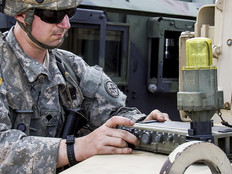Defense Department Moves to Augment GPS with Alternatives
For nearly three decades, the Defense Department has entrusted the Global Positioning System with delivering positioning, navigation and timing (PNT) services critical to U.S. military operations. Over the last several years, though, the global navigation satellite system, prized for its high availability and deadly accuracy, has been under attack. GPS’s reliability, say proponents and detractors alike, has created a dangerously dependent military. This reliance, in turn, makes GPS an irresistible target for cybersecurity attacks.
With assured PNT (A-PNT) as the end goal, the Pentagon and other stakeholders have intensified efforts to secure funding, identify existing systems and develop new technologies to augment GPS.
“We still believe GPS is a very capable system,” says William Nelson, director, Army’s Assured PNT Cross-Functional Team (CFT), who also serves as director of programs and technology for USASMDC/ARSTRAT. “Our goal isn’t to replace it, but to augment it to provide assured PNT in GPS-degraded environments.”
Indeed, while several augmentation options are on the table for A-PNT, they’ll work together to assist and back up GPS, not replace it, according to Brad Parkinson, a professor at Stanford and vice chair of the National Space-Based PNT Advisory Board and the retired Air Force colonel who’s known as the “father of GPS.” Instead, he says, stakeholders should strive to “protect, toughen and augment” GPS and other PNT systems.
For instance, by better protecting frequencies, toughening GPS sets, and augmenting GPS with backup systems, “we’d get a pretty robust package,” says Parkinson. “What we can’t get is anything that approaches the timing and position accuracy of GPS.”
SIGN UP: Get more news from the FedTech newsletter in your inbox every two weeks!
DOD Strives for Reliable, Resilient and Trusted GPS Technology
The Assured PNT Cross-Functional Team has several programs underway, and they fall into three segments.
The first covers A-PNT user equipment programs, which include the fast-tracked Mounted Assured PNT System (MAPS). The project seeks to develop a universal box capable of distributing A-PNT from GPS and alternate systems to multiple GPS clients onboard mounted platforms. Able to access A-PNT in GPS-degraded and denied environments, MAPS incorporates integrity monitoring and anti-jamming capabilities to assess and ensure PNT accuracy.
“We’ve made significant progress on MAPS,” says Nelson, whose team and the Army Rapid Capabilities Office have delivered a working prototype. “Once we finish with requirements for MAPS, we’ll move on to developing a system for dismounted soldiers.”
The second segment comprises “enterprise enablers,” technologies that augment GPS. Particularly promising, says Nelson, are pseudo-satellites — transmitters deployed in terrestrial constellations and, potentially, in aerial vehicles. “These ‘pseudolites’ deliver a high-power signal that’s more difficult to interfere with than the weaker GPS signal,” he says.
The third segment targets “situational awareness.” The Army is committed to supplying accurate situational awareness data through technology that alerts commanding officers when their PNT equipment is compromised. “It’s extremely important that the battlefield commander knows when GPS is jammed or unreliable,” says Nelson. “When they understand the situation, they can make informed decisions based on their environment.”
Situational awareness is critical in the cyberwarfare realm, with its endless cycle of escalating moves and counter-moves. Spoofing attacks that succeed keep targets in the dark long enough to accomplish their objectives, says Todd Humphreys, a professor at the University of Texas at Austin. “Conversely, targets want to detect an attack as soon as possible so they can take corrective action,” he notes.
Nelson’s CFT is also working with the Air Force to ensure a successful transition to M-code, a more secure military signal. This effort, as well as the GPS III and next-gen OCX deployments, are part of the Air Force’s GPS modernization.
Pentagon Evaluates Emerging Tech to Supplement GPS
Ultimately, A-PNT will require a blend of technologies that work in tandem with GPS and can serve as backups. “We need to create enough resilience through augmentation that an adversary trying to disrupt GPS concludes it’s not worth the cost,” says Parkinson.
As it ramps up A-PNT efforts, the Pentagon is assessing established and emerging technologies for augmenting GPS.
New technology that leverages low-earth-orbiting Iridium satellites shows promise, says Humphreys. After Satelles appropriated the satellites, he says, it “modified the communications signals they broadcast to deliver secure position and timing services.” Now, the decade-long effort’s getting some good traction.
Humphreys, like Nelson, believes pseudolites should be at the A-PNT table. “With a signal structure very similar to GPS, they can be enormously helpful in cases where GPS is jammed by tall mountains or buildings,” he says.
Also in the mix are ground-based inertial navigation systems. “While inertials can’t approach GPS accuracy, they’re more resilient and resistant to interference,” says Parkinson. “It also makes sense to consider eLoran, a modern, low-frequency, high-powered ground transmitter.”
DOD Aims to Speed Up Tech Development
Augmenting GPS with other systems and integrating them with hundreds of DOD platforms and devices is a task that demands, at a baseline, that agencies adopt rapid prototyping and testing, open systems, and more-flexible contracting. The Army, for one, is considering working with C5, using Other Transaction Authority funding, to develop A-PNT prototypes. “OTAs support rapid innovation and projects to testing and experimentation much faster than conventional contracting processes,” says Nelson.
Moreover, the CFT is getting close to completing a system architecture (SoSA) for A-PNT for the Army. “With so many platforms acquiring GPS receivers and sensors, we sorely needed an organized architecture to ensure strategies are affordable, incremental and minimize vendor lock,” says Nelson.
Once formalized, the SoSA will guide A-PNT system development cycles and provide direction for system modernization going forward. Publishing it, Nelson says, “will be one of the landmark events for this CFT, and our first real comprehensive attempt to get our hands around this problem.”









